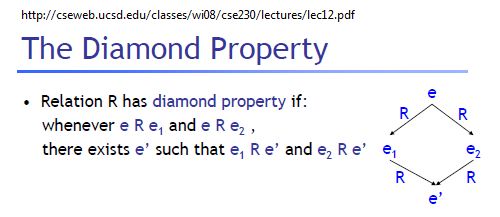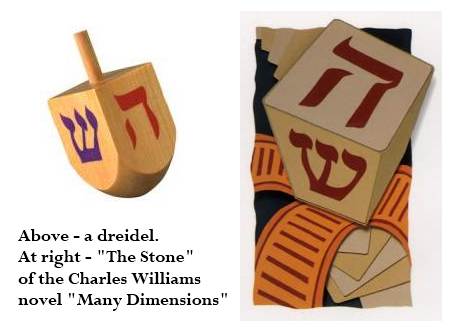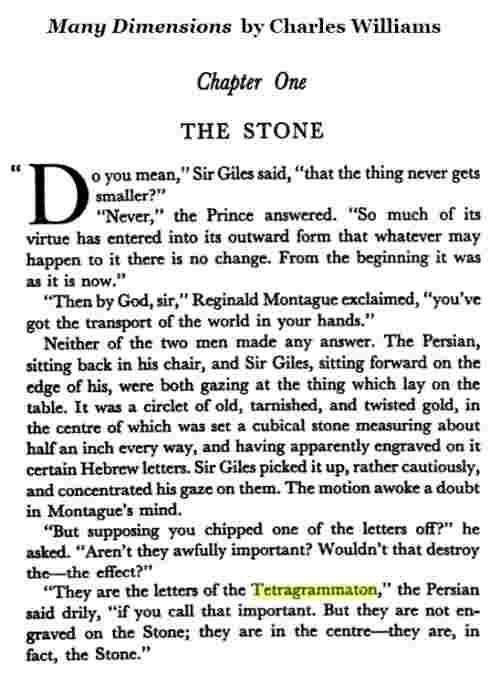"Through the unknown, remembered gate . . . ."
A differently remembered gate —
https://theosophy.wiki/en/Jirah_Dewey_Buck —
" Dr. Jirah Dewey Buck (November 20, 1838 – December 13, 1916)
was a physician who worked to establish one of the first Theosophical
lodges in the United States, the Cincinnati Theosophical Society, and
the American Section of the international Theosophical Society in 1886 . . . ."
"Buck was born in Fredonia, New York
on November 20, 1838 . . . .
[He was] 'a recognized leader of a definite school
of Masonic thought and propaganda'."
The above metadata was suggested by an image I happened to see today,
the "Tetragrammaton of Pythagoras" —

"Duck Soup" fans may recall the war between Freedonia and Sylvania.
For some images more in the spirit of Sylvania, see "Triangles Are Square."
On the recent film "Justice League" —
From DC Extended Universe Wiki, "Mother Box" —
"However, during World War I, the British rediscovered
mankind's lost Mother Box. They conducted numerous studies
but were unable to date it due to its age. The Box was then
shelved in an archive, up until the night Superman died,
where it was then sent to Doctor Silas Stone, who
recognized it as a perpetual energy matrix. . . ." [Link added.]
The cube shape of the lost Mother Box, also known as the
Change Engine, is shared by the Stone in a novel by Charles Williams,
Many Dimensions . See the Solomon's Cube webpage.
See too the matrix of Claude Lévi-Strauss in posts tagged
Verwandlungslehre .
Some literary background:
Who speaks in primordial images speaks to us
as with a thousand trumpets, he grips and overpowers,
and at the same time he elevates that which he treats
out of the individual and transitory into the sphere of
the eternal. — C. G. JUNG
"In the conscious use of primordial images—
the archetypes of thought—
one modern novelist stands out as adept and
grand master: Charles Williams.
In The Place of the Lion he incarnates Plato’s
celestial archetypes with hair-raising plausibility.
In Many Dimensions he brings a flock of ordinary
mortals face to face with the stone bearing
the Tetragrammaton, the Divine Name, the sign of Four.
Whether we understand every line of a Williams novel
or not, we feel something deep inside us quicken
as Williams tells the tale.
Here, in The Greater Trumps , he has turned to
one of the prime mysteries of earth . . . ."
— William Lindsay Gresham, Preface (1950) to
Charles Williams's The Greater Trumps (1932)
For fans of what the recent series Westworld called "bulk apperception" —

From New World Encyclopedia —

See also Tetragrammaton in this journal.
For further context, see Solomon's Cube and Oct. 16, 2013.
The LA Times on last weekend's film "Thor"—
"… the film… attempts to bridge director Kenneth Branagh's high-minded Shakespearean intentions with Marvel Entertainment's bottom-line-oriented need to crank out entertainment product."
Those averse to Nordic religion may contemplate a different approach to entertainment (such as Taymor's recent approach to Spider-Man).
A high-minded— if not Shakespearean— non-Nordic approach to groups acting—
"What was wrong? I had taken almost four semesters of algebra in college. I had read every page of Herstein, tried every exercise. Somehow, a message had been lost on me. Groups act . The elements of a group do not have to just sit there, abstract and implacable; they can do things, they can 'produce changes.' In particular, groups arise naturally as the symmetries of a set with structure. And if a group is given abstractly, such as the fundamental group of a simplical complex or a presentation in terms of generators and relators, then it might be a good idea to find something for the group to act on, such as the universal covering space or a graph."
— Thomas W. Tucker, review of Lyndon's Groups and Geometry in The American Mathematical Monthly , Vol. 94, No. 4 (April 1987), pp. 392-394
"Groups act "… For some examples, see
Related entertainment—
High-minded— Many Dimensions—

Not so high-minded— The Cosmic Cube—

One way of blending high and low—
The high-minded Charles Williams tells a story
in his novel Many Dimensions about a cosmically
significant cube inscribed with the Tetragrammaton—
the name, in Hebrew, of God.
The following figure can be interpreted as
the Hebrew letter Aleph inscribed in a 3×3 square—
The above illustration is from undated software by Ed Pegg Jr.
For mathematical background, see a 1985 note, "Visualizing GL(2,p)."
For entertainment purposes, that note can be generalized from square to cube
(as Pegg does with his "GL(3,3)" software button).
For the Nordic-averse, some background on the Hebrew connection—

Also known, roughly speaking, as confluence or the Church-Rosser property.
From “NYU Lambda Seminar, Week 2” —
[See also the parent page Seminar in Semantics / Philosophy of Language or:
What Philosophers and Linguists Can Learn From Theoretical Computer Science But Didn’t Know To Ask)]
A computational system is said to be confluent, or to have the Church-Rosser or diamond property, if, whenever there are multiple possible evaluation paths, those that terminate always terminate in the same value. In such a system, the choice of which sub-expressions to evaluate first will only matter if some of them but not others might lead down a non-terminating path.
The untyped lambda calculus is confluent. So long as a computation terminates, it always terminates in the same way. It doesn’t matter which order the sub-expressions are evaluated in.
A computational system is said to be strongly normalizing if every permitted evaluation path is guaranteed to terminate. The untyped lambda calculus is not strongly normalizing: ω ω doesn’t terminate by any evaluation path; and (\x. y) (ω ω) terminates only by some evaluation paths but not by others.
But the untyped lambda calculus enjoys some compensation for this weakness. It’s Turing complete! It can represent any computation we know how to describe. (That’s the cash value of being Turing complete, not the rigorous definition. There is a rigorous definition. However, we don’t know how to rigorously define “any computation we know how to describe.”) And in fact, it’s been proven that you can’t have both. If a computational system is Turing complete, it cannot be strongly normalizing.
There is no connection, apart from the common reference to an elementary geometric shape, between the use of “diamond” in the above Church-Rosser sense and the use of “diamond” in the mathematics of (Cullinane’s) Diamond Theory.
Any attempt to establish such a connection would, it seems, lead quickly into logically dubious territory.
Nevertheless, in the synchronistic spirit of Carl Jung and Arthur Koestler, here are some links to such a territory —
Link One — “Insane Symmetry” (Click image for further details)—
See also the quilt symmetry in this journal on Christmas Day.
Link Two — Divine Symmetry
(George Steiner on the Name in this journal on Dec. 31 last year (“All about Eve“)) —
“The links are direct between the tautology out of the Burning Bush, that ‘I am’ which accords to language the privilege of phrasing the identity of God, on the one hand, and the presumptions of concordance, of equivalence, of translatability, which, though imperfect, empower our dictionaries, our syntax, our rhetoric, on the other. That ‘I am’ has, as it were, at an overwhelming distance, informed all predication. It has spanned the arc between noun and verb, a leap primary to creation and the exercise of creative consciousness in metaphor. Where that fire in the branches has gone out or has been exposed as an optical illusion, the textuality of the world, the agency of the Logos in logic—be it Mosaic, Heraclitean, or Johannine—becomes ‘a dead letter.'”
– George Steiner, Grammars of Creation
(See also, from Hanukkah this year, A Geometric Merkabah and The Dreidel is Cast.)
Link Three – Spanning the Arc —
Part A — Architect Louis Sullivan on “span” (see also Kindergarten at Stonehenge)
Part B — “Span” in category theory at nLab —
Also from nLab — Completing Spans to Diamonds
“It is often interesting whether a given span in some partial ordered set can be completed into a diamond. The property of a collection of spans to consist of spans which are expandable into diamonds is very useful in the theory of rewriting systems and producing normal forms in algebra. There are classical results e.g. Newman’s diamond lemma, Širšov-Bergman’s diamond lemma (Širšov is also sometimes spelled as Shirshov), and Church-Rosser theorem (and the corresponding Church-Rosser confluence property).”
The concepts in this last paragraph may or may not have influenced the diamond theory of Rudolf Kaehr (apparently dating from 2007).
They certainly have nothing to do with the Diamond Theory of Steven H. Cullinane (dating from 1976).
For more on what the above San Francisco art curator is pleased to call “insane symmetry,” see this journal on Christmas Day.
For related philosophical lucubrations (more in the spirit of Kaehr than of Steiner), see the New York Times “The Stone” essay “Span: A Remembrance,” from December 22—
“To understand ourselves well,” [architect Louis] Sullivan writes, “we must arrive first at a simple basis: then build up from it.”
Around 300 BC, Euclid arrived at this: “A point is that which has no part. A line is breadthless length.”
See also the link from Christmas Day to remarks on Euclid and “architectonic” in Mere Geometry.
The Dreidel Is Cast
The Nietzschean phrase "ruling and Caesarian spirits" occurred in yesterday morning's post "Novel Ending."
That post was followed yesterday morning by a post marking, instead, a beginning— that of Hanukkah 2010. That Jewish holiday, whose name means "dedication," commemorates the (re)dedication of the Temple in Jerusalem in 165 BC.
The holiday is celebrated with, among other things, the Jewish version of a die— the dreidel . Note the similarity of the dreidel to an illustration of The Stone* on the cover of the 2001 Eerdmans edition of Charles Williams's 1931 novel Many Dimensions—

For mathematics related to the dreidel , see Ivars Peterson's column on this date fourteen years ago.
For mathematics related (if only poetically) to The Stone , see "Solomon's Cube" in this journal.
Here is the opening of Many Dimensions—

For a fanciful linkage of the dreidel 's concept of chance to The Stone 's concept of invariant law, note that the New York Lottery yesterday evening (the beginning of Hanukkah) was 840. See also the number 840 in the final post (July 20, 2002) of the "Solomon's Cube" search.
Some further holiday meditations on a beginning—
Today, on the first full day of Hanukkah, we may or may not choose to mark another beginning— that of George Frederick James Temple, who was born in London on this date in 1901. Temple, a mathematician, was President of the London Mathematical Society in 1951-1953. From his MacTutor biography—
"In 1981 (at the age of 80) he published a book on the history of mathematics. This book 100 years of mathematics (1981) took him ten years to write and deals with, in his own words:-
those branches of mathematics in which I had been personally involved.
He declared that it was his last mathematics book, and entered the Benedictine Order as a monk. He was ordained in 1983 and entered Quarr Abbey on the Isle of Wight. However he could not stop doing mathematics and when he died he left a manuscript on the foundations of mathematics. He claims:-
The purpose of this investigation is to carry out the primary part of Hilbert's programme, i.e. to establish the consistency of set theory, abstract arithmetic and propositional logic and the method used is to construct a new and fundamental theory from which these theories can be deduced."
For a brief review of Temple's last work, see the note by Martin Hyland in "Fundamental Mathematical Theories," by George Temple, Philosophical Transactions of the Royal Society, A, Vol. 354, No. 1714 (Aug. 15, 1996), pp. 1941-1967.
The following remarks by Hyland are of more general interest—
"… one might crudely distinguish between philosophical and mathematical motivation. In the first case one tries to convince with a telling conceptual story; in the second one relies more on the elegance of some emergent mathematical structure. If there is a tradition in logic it favours the former, but I have a sneaking affection for the latter. Of course the distinction is not so clear cut. Elegant mathematics will of itself tell a tale, and one with the merit of simplicity. This may carry philosophical weight. But that cannot be guaranteed: in the end one cannot escape the need to form a judgement of significance."
— J. M. E. Hyland. "Proof Theory in the Abstract." (pdf)
Annals of Pure and Applied Logic 114, 2002, 43-78.
Here Hyland appears to be discussing semantic ("philosophical," or conceptual) and syntactic ("mathematical," or structural) approaches to proof theory. Some other remarks along these lines, from the late Gian-Carlo Rota—
See also "Galois Connections" at alpheccar.org and "The Galois Connection Between Syntax and Semantics" at logicmatters.net.
* Williams's novel says the letters of The Stone are those of the Tetragrammaton— i.e., Yod, He, Vau, He (cf. p. 26 of the 2001 Eerdmans edition). But the letters on the 2001 edition's cover Stone include the three-pronged letter Shin , also found on the dreidel . What esoteric religious meaning is implied by this, I do not know.
Powered by WordPress